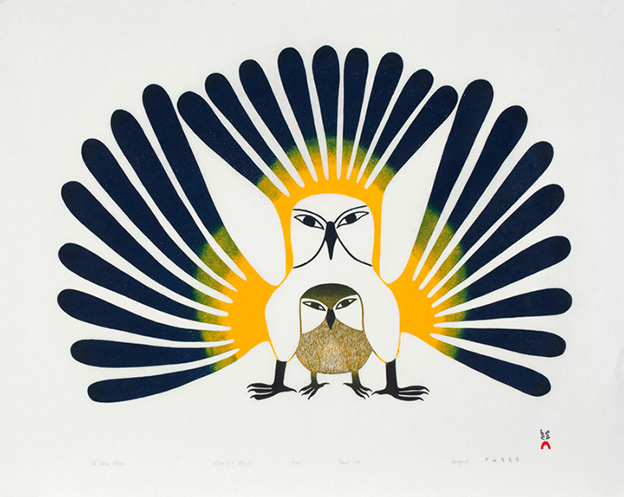Chapter 2 Observing the Sky: The Birth of Astronomy
2.3 Astronomy of the First Nations of Canada
Here is a very small start to share some of the wealth of knowledge about astronomy and the seasons of the First Nations of Canada. As I type this in August 2018 I wish to acknowledge that chapter is is a small token of the rich culture and encourage sharing of information on this important topic.
Truth and Reconciliation
Canada is beginning a journey of Truth and Reconciliation. As it says on the official website (link here for more information) http://reconciliationcanada.ca/?gclid=COCQ0fjrxtUCFQ5Efgodox4GFw (http://tiny.cc/h4fxqy) “Born from the vision of Chief Dr. Robert Joseph, Gwawaenuk Elder, Reconciliation Canada is leading the way in engaging Canadians in dialogue and transformative experiences that revitalize the relationships among Indigenous peoples and all Canadians. Our model for reconciliation engages people in open and honest conversation to understand our diverse histories and experiences. We actively engage multi-faith and multi-cultural communities to explore the meaning of reconciliation. Together, we are charting a New Way Forward.”
National Indigenous Person’s Day Occurs at or close to the Summer Solstice in Canada
https://www.aadnc-aandc.gc.ca/eng/1100100013718/1100100013719#sct1

June 21 is National Indigenous Peoples Day. This is a day for all Canadians to recognize and celebrate the unique heritage, diverse cultures and outstanding contributions of First Nations, Inuit and Métis peoples. The Canadian Constitution recognizes these three groups as Aboriginal peoples, also known as Indigenous peoples.
Although these groups share many similarities, they each have their own distinct heritage, language, cultural practices and spiritual beliefs.
In cooperation with Indigenous organizations, the Government of Canada chose June 21, the summer solstice, for National Aboriginal Day, now known as National Indigenous Peoples Day. For generations, many Indigenous peoples and communities have celebrated their culture and heritage on or near this day due to the significance of the summer solstice as the longest day of the year.
Dene Suline Artist Janvier’s abstract “Morning Star” Mural at the Museum of History in Ottawa
Janvier’s mural illustrates the history of this land from the artist’s Dene Suline perspective. The white circle in the centre is the morning star, a guiding light and the source of all creation. Shards of colour radiating from the star — suggestive of traditional Dene quillwork — represent Aboriginal cultures, while more organic, curvilinear shapes represent the introduction of European ideas and beliefs. Morning Star depicts five centuries of conflict and coexistence, while at the same time expressing hope for mutual respect and conciliation between Aboriginal and European traditions. https://www.historymuseum.ca/blog/alex-janviers-morning-star-shines-brighter-than-ever/
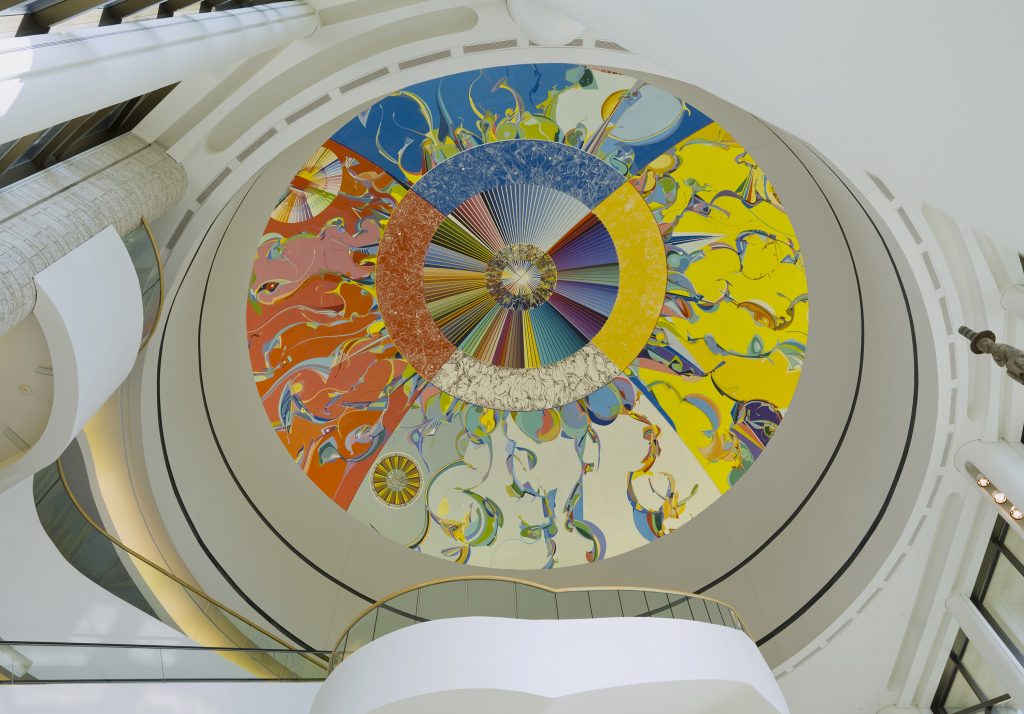
Alex Janvier’s dome mural, Morning Star, appears to float above the staircase rising from the River Salon at the end of the Grand Hall. Spectacular views of the Ottawa River and beyond, to the Canadian Parliament buildings, are visible from ground level and as you climb the stairs toward the mural. The integration of these external natural and built environments with Janvier’s artwork was fundamental to the design intentions of the museum’s architect, Douglas Cardinal. This information is from the Museum’s web site https://www.historymuseum.ca/morningstar
https://www.historymuseum.ca/cmc/exhibitions/tresors/treasure/283eng.shtml
As stated in the video on that site, the artist explains the significance of the mural’s name “Morning Star”, “…my people had used the Morning Star as a guide light in the early mornings of the winter hours …. according to the stars in the sky and especially that one, they pretty well have an idea of the direction they’re going ….”
Alex Janvier was born in 1935 on Le Goff Reserve near Cold Lake, Alberta, Alex Janvier was raised in the Chipewyan tradition, speaking the Dene language until attending the Blue Quill Residential Indian School when he was eight years old. Following high school, Janvier attended the Alberta College of Art in Calgary, where he first experimented with modernist abstractions. Although he achieved some personal and critical success in the early 1960s, it was not until 1971 that he devoted himself to his art on a full-time basis.
British Columbia: Nisga’a Hobiyee (Crescent Moon in February)
This information is gathered from the Nisga’a Nation’s web site. http://nnkn.ca/files/Hoobiyee-2012.pdf (http://tiny.cc/v5fxqy) The Halayt is often referred to as a spiritual leader, medicine man or doctor—the Swaîiskw, or Swaîisgwit; some were also described as “having the ability to forecast the weather” hence astronomers and astrologists, the Guxw-Hloksit. The Halayt-Simgigat studied the Buxw-laks moon, the moon of February, and they made note of the different shapes leading up to the full moon. Over time, 3 they observed that whenever the first crescent moon (thin-shaped) is in the shape of the Hoobix – the bowl of the Nisga’a wooden spoon with the ends pointing upward, this meant abundant resources in the harvesting seasons to follow in K’alii-Aksim Lisims (the Nass Valley). The oolichans would be plentiful, the salmon … berries … and various other resources important to the Nisga’a; all in all, a bountiful year predicted.
As it states at the start of the document from which the above information is quoted, “the oral tradition, the information as contained in this document is by no means conclusive. Nonetheless, this documented information is about a very significant aspect of our Nisga’a way of life which by our Ayuuk – customs and laws – is to be treated with RESPECT. To the young ones, be careful in how you use or interpret information when you hear it. Ensure that you fully understand what is being transmitted to you.” Know that this particular information belongs to the Nisga’a nation. Aamhl Sayt-K’yoolims Gatguë gans dip îisië. May we be one / united as a people. Transcribed and edited by: Ksim Sook’/Nita Morven, Researcher-Ayuukhl Nisga’a Dept. Nisga’a Lisims Government
Alberta and Saskatchewan: Stone Circles
There are many stone circles, often called Medicine Wheels, in Alberta and Saskatchewan. Iniskim Umaapi is an archaeological site of the Blackfeet Nation located south of Bassano, Alberta. Also called the Majorville Cairn and Medicine Wheel. It has been reliably dated to be more than 5000 years old. http://blackfootcrossing.ca/circles.html
https://www.travelalberta.com/ca/listings/majorville-cairn-and-medicine-wheel-6197/
There is controversy about whether or not there is a link to astronomy with these ancient artifacts but they are of culturally important.
http://www.virtualsk.com/current_issue/endangered_stones.html
http://saskhistoryonline.ca/islandora/object/paton%3A489
From the University of Saskatchewan’s SaskHistoryOnLine project.
http://saskhistoryonline.ca/islandora/object/paton%3A825
Nova Scotia: Mi’kmaq Sky Story: Muin and the Seven Bird Hunters
As part of the 2009 International Year of Astronomy, Muin and the Seven Bird Hunters, a traditional sky story which has been handed down from generation to generation as part of the rich oral history of the Mi’kmaq First Nation was shared with the rest of Canada. The story links the annual cycle of the seasons as observed by the Mi’kmaq with the movement of stars about the North Celestial pole. This is the first time this story has been transferred from the realm of oral tradition into video and made accessible to such a large audience.
On January 8th 2009, an animated version of the story was premiered at the Canadian Science and Technology Museum in Ottawa. Versions are now available in English, French and Mi’kmaq to people around the world! The Mi’kmaq version, with an English introduction, can be viewed here (http://tiny.cc/q6fxqy).
The story of Muin has been brought to life thanks to the loving work of Mi’kmaq Elder Lillian Marshall (bio http://tiny.cc/l8fxqy) of Potlotek First Nation (in Cape Breton, NS) and Mi’kmaq Elder Murdena Marshall (bio http://tiny.cc/k9fxqy) of Eskasoni First Nation (in Cape Breton, NS), in conjunction with (artist Sana Kavanagh of Cape Breton University in Sydney, NS. The two Elders narrated the English and Mi’kmaq versions of the film, while the French version was narrated by Annabelle Welsh, a Grade 12 student from Membertou First Nation (in Cape Breton, NS) who attends Étoile de l’Acadie in Sydney. The production was made possible through the support of CBU’s Canada Research Chair in Integrative Science, Dr. Cheryl Bartlett (full credits http://tiny.cc/y6fxqy).
It is hoped that this rich and vibrant story will help encourage other efforts to revitalize Aboriginal night sky stories across Canada. In this way, the richness of knowledge within the Indigenous sciences in Canada can be celebrated and, as deemed appropriate, shared… becoming legacies for children and youth of all ages as well as adults, long after the International Year of Astronomy 2009 is over.
Inuit
The Canadian Museum of History is located in Ottawa, Ontario, Canada. It has a large selection of prints by contemporary Inuit artists. https://www.historymuseum.ca/capedorsetprints/introduction/
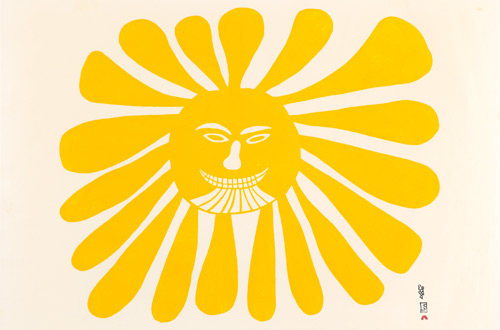
You can follow the link to find the story behind this print, which is an origin story of the Sun and the Moon.
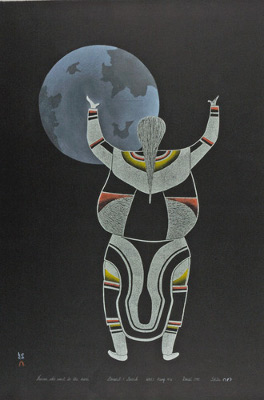
Copyright information. The Museum allows the artwork shown here to be displayed for non-commercial reproduction.
https://www.historymuseum.ca/about/copyright-and-permissions/#tabs
You can read about the artwork shown below, Welcome to the Sun by Kenojuak Ashevak and Kavavaow Mannomee. This photo is of the two artist in the process of creating the print “The Sun’s Return”, created by the stonecut and stencil technique. Here is more information about the artist and her Sun art. https://www.pressreader.com/canada/inuit-art-quarterly/20180315/281547996414433
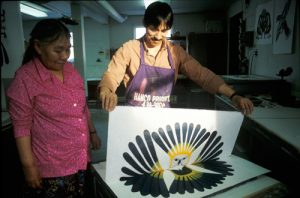
One of the prints is displayed at McMaster University in Ontario. Here is a link to the article about the collection. https://dailynews.mcmaster.ca/article/museum-receives-major-collection-of-inuit-art/
